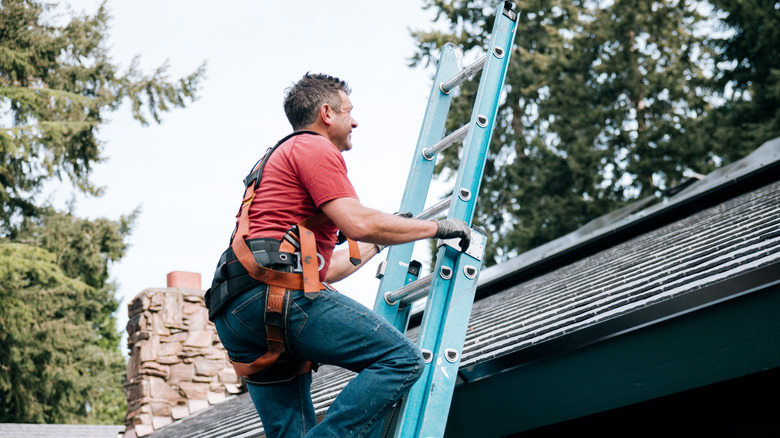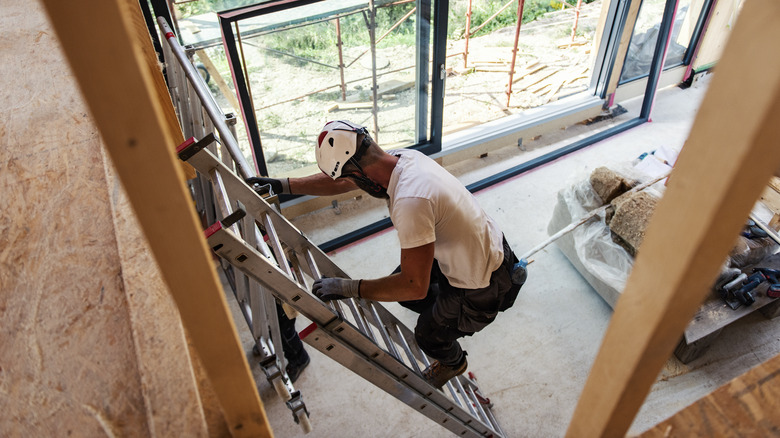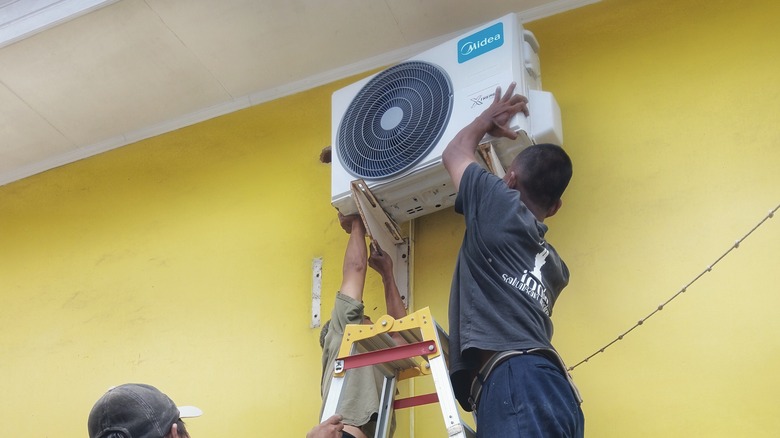
Ryanjlane/Getty Images
A ladder is an essential tool. Whether you’re installing a light bulb in your apartment or patching up the roof of your house, using a ladder offers an efficient way to reach locations that would be unsafe otherwise. If you’re in the market for a new ladder, consider getting one from your local Harbor Freight.
There are certainly some items you should think twice about before getting from Harbor Freight, but ladders are thankfully not among them. While it may not sport the widest variety out there, the retailer’s selection has received high ratings from buyers who have come to appreciate their ladders’ wide assortment of applications, from painting around the house to cutting tree branches and more. And like much of Harbor Freight’s economical selection, their ladders typically come at lower prices than what you’ll find at the likes of Home Depot and Lowe’s.
But like every tool out there, no two ladders are the same, with each sporting specific traits that make them well-suited for different tasks. So before getting yours, finding out which ladder is best for you will go a long way in helping you do your job. But first, it’s important to identify the characteristics that set ladders apart. We’ve put together an easy guide breaking down these characteristics and what to expect from Harbor Freight’s selection.
What kind of ladders does Harbor Freight carry?
While Harbor Freight has good, economical ladder choices, it sports far fewer ladders than other retailers with just three of them in its collection. And that doesn’t include the handful of stools and step stools that are also available.
All the Harbor Freight ladders are from Franklin, a brand that carries a wide range of household support and transport solutions including hand trucks, moving blankets, hardwood dollies, stud finders, and much more. The first of its ladders is the $79.99 6 Ft. Type II Fiberglass Step Ladder, a lightweight, fiberglass ladder suitable for indoor and outdoor work with a 225-pound weight capacity.
The second tallest is the $149.99 14 ft. Type I Portable Telescoping Ladder. Able to support upwards of 250 pounds, what makes this aluminum ladder stand out most is the ease of transport with its ability to retract from 14 feet tall to only 31 inches. The tallest is the $159.99 17 ft. Type IA Multi-Task Ladder with a carrying capacity of 300 pounds. It’s an especially versatile model with several different configurations, from a staircase ladder to an A-Frame, to scaffolding and more. Thankfully, all of these ladders have stellar reviews from customers, with the lowest sporting a 4.6 out of five-star rating average.
How tall do you need it?

Vitranc/Getty Images
Of course, the most likely reason you need a ladder is to reach inaccessible places. That’s why the first thing to consider is how tall your ladder needs to be. Consider the functions you need it for — a ladder used to help paint your bedroom walls probably shouldn’t be as tall as one being used to reach a roof.
Taking height into consideration is also a crucial step in ensuring your safety. This means that along with the height of the ladder itself, you should also take your reach height into account. In general, according to Lowes, you don’t want to stand higher than two steps away from the top of the ladder, otherwise you risk losing balance. You’ll also want three points of contact on the ladder while using it at all times, whether that be both feet and one hand or both hands and one foot. Can you sufficiently perform your duties from this height while remaining firmly supported?
The ladder should also be sturdily reinforced. Along with its feet secured to the ground, the ladder itself should be supported by the surface it’s resting against as you work. Another good rule of thumb in this regard is to make sure that the ladder extends three feet above the support point to ensure you don’t need to climb too high on the ladder in order to work.
How much weight does it need to support?

kam_gaw4i/Shutterstock
Weight capacity is another crucial component to consider when it comes to finding a ladder. Along with keeping your own bodyweight in mind, take time to think of what you will be working with while on the ladder. Will you be handling any power tools? Will you tend to any heavy machinery that needs to be taken up or down the ladder? Knowing how much weight your ladder needs to support beforehand will aid in making your job a lot easier.
You may have noticed that the Harbor Freight ladders we described earlier had a specific Type classification. These ratings, outlined by the American National Standards Institute, indicate the ladder’s load capacity. On the extreme ends of the spectrum are Type III ladders, which have the lightest load capacity at 200 pounds, and Type IAA ladders, which can bear upwards of 375 pounds.
Harbor Freight currently possesses no ladders in either of these categories, with its selection representing the three intermediate ratings. These include Type II ladders that can carry up to 225 pounds, Type I ladders at 250 pounds, and Type IA at 300 pounds. While this might make Harbor Freight ladders a lesser choice for those working in heavy-duty environments, they should be better suited for most average homeowners.
What material is it made of?
While it may not be the first thing on your mind when picking out a new ladder, understanding what your ladder is made of is another important factor to consider. Ladders can be constructed out of a wide array of materials, each with their own pros and cons.
There are four primary materials used to make ladders. Off the bat, you won’t find any made out of either wood or steel at Harbor Freight — which is probably for the best. While wood ladders make for a solid, affordable option, they also require more maintenance to avoid deterioration or the growth of mold and fungi. Steel is better suited for hefty jobs, but is prone to rusting over time if exposed to moisture. It can also be uncomfortable to work on in the heat, and it’s an electrical conductor.
If seeking a ladder from Harbor Freight, you can choose between fiberglass or aluminum. Fiberglass is a good option if you’re seeking a light ladder that still has density and strength. Additionally, they are extremely durable to both the elements and extreme use. However, aluminum might be your best bet. These ladders strike a perfect balance of strength, durability, and convenience while remaining affordable, helping them be among the most popular ladder choice for most users.